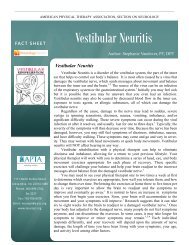PT Evaluation for Dizziness and Postural Instability - Neurology ...
PT Evaluation for Dizziness and Postural Instability - Neurology ...
PT Evaluation for Dizziness and Postural Instability - Neurology ...
Create successful ePaper yourself
Turn your PDF publications into a flip-book with our unique Google optimized e-Paper software.
AMERICAN PHYSICAL THERAPY ASSOCIATION, SECTION ON NEUROLOGYFACT SHEETPhysical Therapy <strong>Evaluation</strong> <strong>for</strong><strong>Dizziness</strong> <strong>and</strong> <strong>Postural</strong> <strong>Instability</strong>Author: Mike Studer, <strong>PT</strong>, MHS, NCS, CEEAAWhen in<strong>for</strong>mation from one or both inner ears is reduced or absent, the brainbecomes increasingly dependent on other <strong>for</strong>ms of sensory in<strong>for</strong>mation, such asvisual <strong>and</strong> somatosensory input. Damage or loss of inner ear input can result in awide range of symptoms including imbalance, dizziness, vertigo, nausea, motionsensitivity, <strong>and</strong> blurred vision.A physical therapist specializing in vestibular treatment can best help with thedifferential diagnosis <strong>and</strong> evidence-based treatment of individuals with dizziness,vertigo, <strong>and</strong> unsteadiness. Components of a specialized examination, with somespecific examples, are listed below:1111 North Farifax StreetAlex<strong>and</strong>ria, VA 22314-1488Phone: 800-999-2782,Ext 3237Fax: 703-706-8578Email: neuro@apta.orgwww.neuropt.orgOculomotor <strong>and</strong> vestibulo-ocular testingDynamic Visual Acuity – investigating the nervous system organization ofhead <strong>and</strong> eye motion, through the vestibulo-ocular reflex. 1,2Positional <strong>and</strong> movement testing Dix-Hallpike – test <strong>for</strong> benign paroxysmal positional vertigo (BPPV). 3Motion Sensitivity Quotient – objectively documenting the relative sensitivityof various movements <strong>and</strong> positions on the patient’s symptoms ofdizziness. 4Balance assessmentClinical test of Sensory Integration in Balance (CTSIB) that helps to determinewhat role each of the three sensory systems (vestibular, visual <strong>and</strong>somatosensory) are playing in the patient’s balance responses. 5,6Computerized Dynamic Posturography (CDP) – using a <strong>for</strong>ce plate, visualtarget <strong>and</strong> moving surround to objectify the patients capabilities to resolvesensory conflict in ef<strong>for</strong>ts to balance in st<strong>and</strong>ing. 7Gait evaluationDynamic Gait Index (DGI) – used to objectively rate balance in walking <strong>and</strong>the responsiveness or sensitivity of the vestibular system to everyday activities.8
AMERICAN PHYSICAL THERAPY ASSOCIATION, SECTION ON NEUROLOGYPhysical Therapy <strong>Evaluation</strong> <strong>for</strong><strong>Dizziness</strong> <strong>and</strong> <strong>Postural</strong> <strong>Instability</strong>Proprioception, kinesthesia, touch, <strong>and</strong> pressure assessmentCoordinationRange of motion <strong>and</strong> strength<strong>Postural</strong> assessmentMany pathologies cause vertigo, dizziness, or imbalance – some are listed below.Rely on a trained Vestibular Physical Therapist <strong>for</strong> the best rehabilitative care ofthese conditions.Acoustic neuroma Bilateral vestibular loss BPPVCervicogenic dizziness Chronic subjective dizziness ConcussionLabyrinthitis Meniere’s disease MeningitisMigraine Multisensory disequilibrium NeuritisSyphilisReferences:1111 North Farifax StreetAlex<strong>and</strong>ria, VA 22314-1488Phone: 800-999-2782,Ext 3237Fax: 703-706-8578Email: neuropt@apta.orgwww.neuropt.org1. Longridge NS, Mallinson AI. The dynamic illegible E (DIE) test: a simple technique <strong>for</strong>assessing the ability of the vestibulo-ocular reflex to overcome vestibular pathology. JOtolaryngol. 1987; 16: 97-103.2. Longridge NS, Mallinson AI. The dynamic illegible E-test. A technique <strong>for</strong> assessing thevestibulo-ocular reflex. Acta Otolaryngol. 1987; 103: 273-279.3. Dix R, Hallpike CS. The pathology, symptomatology <strong>and</strong> diagnosis of certain commondisorders of the vestibular system. Ann Otol Rhinol Laryngol. 1952; 6: 987-1016.4. Shepard NT, Telian SA. Programmatic vestibular rehabilitation. Otolaryngol Head Neck Surg.1995; 112: 173-182.5. Shumway-Cook A, Horak FB. Assessing the influence of sensory interaction of balance:suggestion from the field. Phys Ther. 1986; 66: 1548-1550.6. Horak FB. Clinical measurement of postural control in adults. Phys Ther. 1987; 67: 1881-1885.7. Black FO. Clinical status of computerized dynamic posturography. Curr Opin Otolarygol HeadNeck Surg. 2001;9:314-318.8. Shumway-Cook A, Woollacott M. Motor Control: Theory <strong>and</strong> Practical Applications. 1st ed.Baltimore, MD: Williams <strong>and</strong> Wilkins; 1995.
















